Non-Objective Art – Creation in the Absence of Representation
What is non-objective art? Who are the pioneering artists of the movement? And is there any significance to non-objective art? These are just a few questions we will unpack in this article that deals with non-representational art and its relationship to abstract art. You may have encountered an artwork that left you questioning the significance of abstract art, and mark-making on artwork that seems entirely irrelevant to the title. While the two terms are often confused with each other, you will certainly have a clearer picture of what these terms mean and how non-objective art can bring meaning despite its stereotypical character.
Contents
- 1 A Non-Objective Art Definition: What Is Non-Objective Art?
- 2 Non-Objective Art Examples
- 2.1 Komposition 4 (1911) by Wassily Kandinsky
- 2.2 Non-Objective Painting no. 80 (Black on Black) (1918) by Aleksandr Rodchenko
- 2.3 Suprematist Composition: White on White (1918) by Kazimir Malevich
- 2.4 Construction in Space: Diagonal (1921 – 1925) by Naum Gabo
- 2.5 Two Grays II (1928) by Frantisek Kupka
- 2.6 Blue Construction (1938) by Roland David Smith
- 2.7 Synchromy in Dark Blue (1941) by Auguste Herbin
- 2.8 Fluorescent Complement (1960) by Richard Anuszkiewicz
- 2.9 Study for Homage to the Square (1964) by Josef Albers
- 2.10 Table Piece CCLXVI (1975) by Sir Anthony Caro
- 2.11 Riallaro (1995) by Frank Stella
- 2.12 Brushstrokes (1995) by Sol LeWitt
- 3 Frequently Asked Questions
A Non-Objective Art Definition: What Is Non-Objective Art?
What is non-objective art? Non-objective art is also understood as artwork that does not intend to represent a specific form or subject and is also labeled non-representational. A detailed non-objective art definition includes the genre in art as a segment of abstract art that does not express physical representations of real-world objects, individuals, and other aspects of the natural environment.
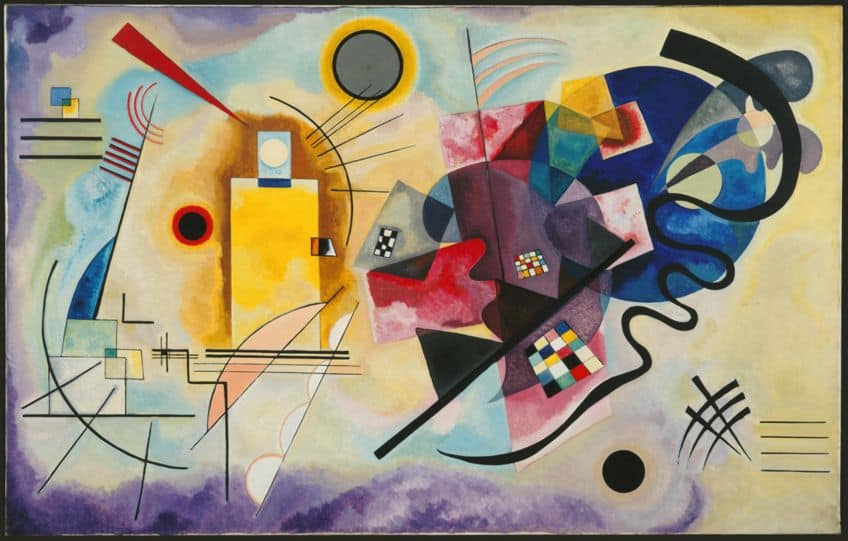
When thinking about the idea of non-objective art vs. abstract art, one should take note that the term “non-objective art” is often interchanged in the context of referring to artwork that is abstract in appearance and does not visually depict an identifiable subject or object. The term “abstract art” on the other hand, refers to artwork that may also include visual expressions of real-world objects and may also extend to depictions that are completely non-representational. Simply stated, there is no clear boundary between non-objective art vs. abstract art, rather, it is useful to think of non-objective art as part of the genre of abstract art that chooses to not represent too much or express recognizable images.
It is important to not categorize non-objective art under the movement of Abstraction, rather, to think of it as an approach or style that can be adopted across different art styles.
Other non-objective art definitions include the mention of additional terms that are substituted for non-objective or non-representational art and include minimalist art, geometric art, and abstraction. A few other art styles may also come to mind that focus on non-representation and can include styles derived from movements such as Futurism, Russian Suprematism, Constructivism, Cubism, Bauhaus, and Op art.
The Elements of Non-Objective Art
What makes a painting or artwork non-objective? Not only does its lack of clear representation make an artwork non-objective, but so do the artwork’s individual qualities. In the broader spectrum of non-objective art, one will notice that non-representational abstract works would avoid painting techniques such as impasto and generally tend toward flat shapes, geometric shapes, unnatural rigid forms, and a mathematical inclination, which is visually represented by lines and confident gestures that seem intention in their placement, yet do not intend to represent anything specific. Non-objective artworks also open themselves up to color in a selective manner, which may be symbolic at most. Flat planes are another element of non-objective artwork that focuses less on traditional modes of perspective in drawing or painting and more on the simplicity of shape, form, and texture. In this way, the approach to non-objective art is considered minimal.
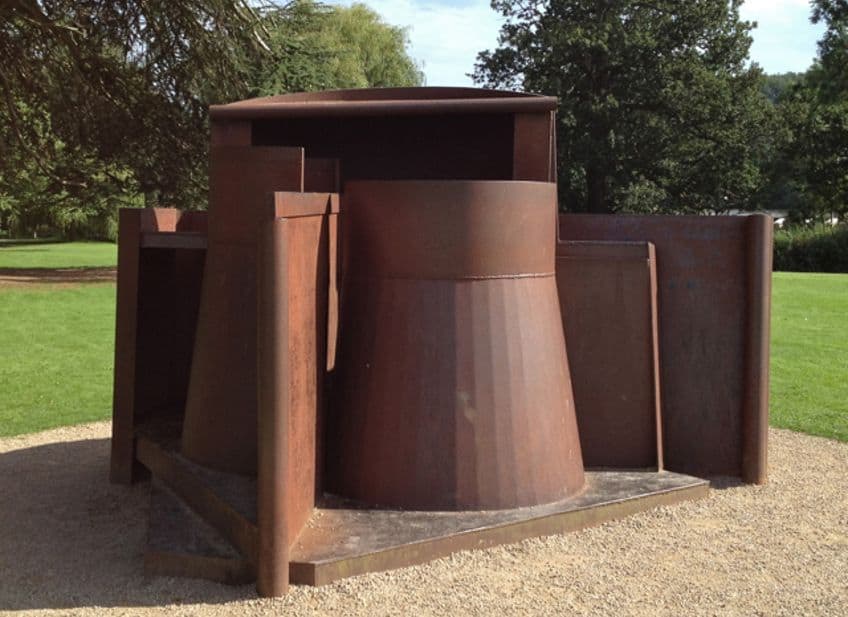
Color and Gesture in Non-Objective Art
The use and function of color and gesture in non-objective art vary according to the movement and context of the movement in that non-objective art is created. Popular non-objective artists include artists such as Wassily Kandinsky, Piet Mondrian, Kasimir Malevich, and Alexander Rodchenko, all of whom expressed their approach to abstraction and non-objective art-making in line with their unique backgrounds and contexts. Color can be used in an identifiable manner since it forms part of the basic elements of art and is therefore one of the few recognizable points of attachment for the viewer.
Color can therefore be employed in non-objective artworks on a relational basis to the context of the artwork and become an artist’s signature style.
This can be seen in the case of Piet Mondrian, whose signature use of primary colors and grid features has become a trademark style of Mondrian’s legacy, and as such, is identifiable as a reference through color. Other non-objective painters belonging to the Russian Suprematism movement also focused on fast, primary colors that were adopted in a different visual manner yet highlights the importance of color and its gestural use in allowing for the development of non-objective art across different movements.
The Significance of Non-Objective Art
One can appreciate and visually enjoy the many visual manifestations of non-objective art by learning more about some of the key influences and artworks of the art style that shapes its popularity, which we will further explore in the non-objective art examples section below. Before we jump in, let us enlighten you on the significance of non-representational art.
You may have seen a non-objective painting that had you question the validity of abstract art itself, but do not let the initial reaction deter you from understanding the value of non-objectivity in art and the way that producing visuals that are devoid of obvious meaning can have on the psyche. Each day, we are constantly stimulated by our environment and personal realities that can become overwhelming and condition one to always be on the search for identifiable meaning. Being able to identify something brings one comfort and can also, on the other hand, condition one into comfort and dependence on the familiar. Abstract and non-objective art highlights the essence of the unknown by presenting viewers with an image or composition that is unidentifiable at first, and perhaps subconsciously, relatable via color and shape.
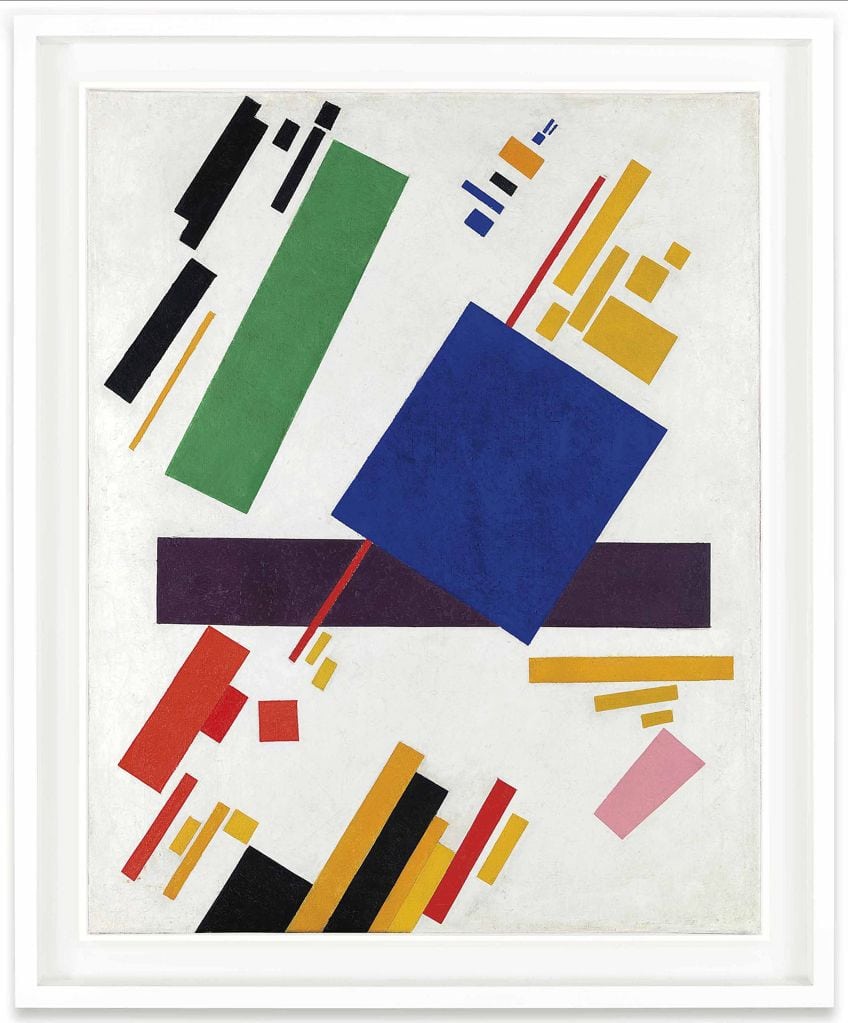
A major aspect of non-objective art as featured in art history is the use of geometry and the appeal of linear, rigid, and mathematical shapes that outline a sense of universal comfort, that the artwork of abstract concoction must possess some universal value, and is thus valuable, even if not understood for its lack of visual representation.
Can art truly be non-representational? You might be led to enquire into questions around the nature of representation in art and whether an artist can remove themselves from their work to be interpreted as “non-representational”. One such artist who helped broaden the notion of representation and non-objectivity in art is René Magritte, whose painting The Treachery Of Images (1929) presented an image of a pipe with a text that read “Ceci n’est pas une pipe”. The French text was translated into English to “this is not a pipe” and stirred the art world to reassess their vision of reality and representation.
An important aspect worth noting of Magritte’s painting is that it was executed in a realist fashion, which implies that the object was not a real pipe but rather a painting of a pipe and thus negates the perfectionistic tendency of realists while making clear the role of art in distinguishing reality from “the copy”.
Non-Objective Art Examples
Now that you have an in-depth overview of the nature and form of non-objective art in art history, you can now enjoy some famous non-objective art examples from the last two centuries that challenge and transform the concepts of non-representation through mark-making, gesture, abstraction, shapes, and color.
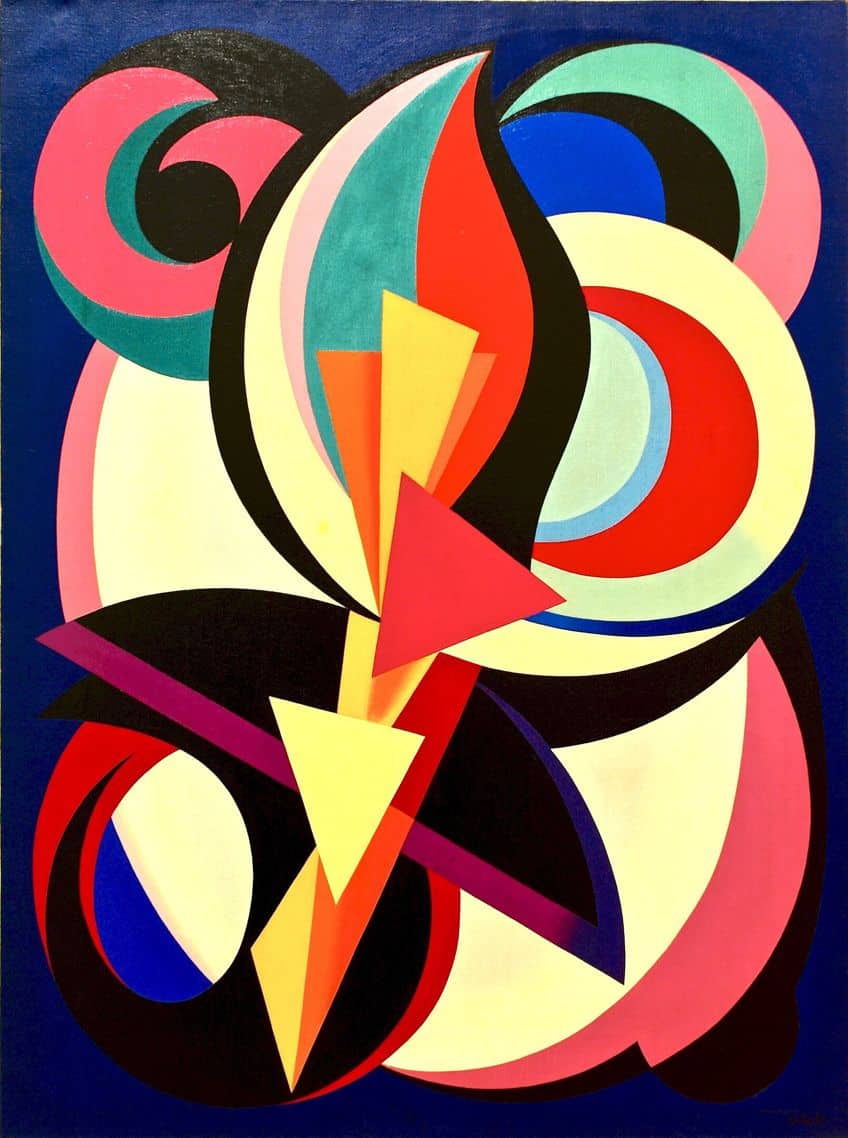
Komposition 4 (1911) by Wassily Kandinsky
| Artist Name | Wassily Kandinsky (1866 – 1944) |
| Date | 1911 |
| Medium | Oil on canvas |
| Dimensions (cm) | 159.5 x 250.5 |
| Where It Is Housed | Düsseldorf Kunstsammlung Nordrhein-Westfalen, Düsseldorf, Germany |
Wassily Kandinsky was one of the leading figures of non-objective art, who only pursued his artistic passions in his thirties after engaging in a law career in Moscow. Kandinsky was fueled by the talents of Parisian artists of the late 19th century and established his own school called Phalanx, which was a progressive educational organization. In the early 20th century, Kandinsky began receiving attention and exhibited his work at the Salon d’Automne in 1904. His work was initially criticized in a positive yet mild light for his use of bright colors and fairytale themes. Kandinsky’s approach to abstract and non-objective painting was thereafter rooted in his distrust for the presentation of any form of reality in art and drew connections to the scientific disintegration of an atom.
Science shook up Kandinsky’s world and as such, his art was centered on the spiritual, mystical, and metaphysical instead of reality as many claimed understood it.
Komposition 4 is a non-objective painting by Kandinsky that illustrates an abstract arrangement of color and features sinuous agile black lines in no apparent pattern or intentional shape. The primary colors stand out in the painting and vaguely remind one of the colors of the rainbow. The marks and gestures on the painting are all quite vague and reflect Kandinsky’s interest at the time to locate ways to “parallel the immediately expressive” nature of music, which is intangible and a great way to explore themes of non-objective mark-making. Kandinsky’s art also pinpoints an overarching theme of non-conformity that is embedded in the historical nature of non-objective art. Some of Kandinsky’s major publications include Concerning the Spiritual in Art (1911) and Blaue Reiter Almanac (19120, which introduced important principles for the development of Modern art. Aspects of Kandinsky’s art such as sensation and color perception are two of the leading components that he used to create non-objective art. Paintings from his Compositions series are among the best of his works that reflect a sense of completeness.
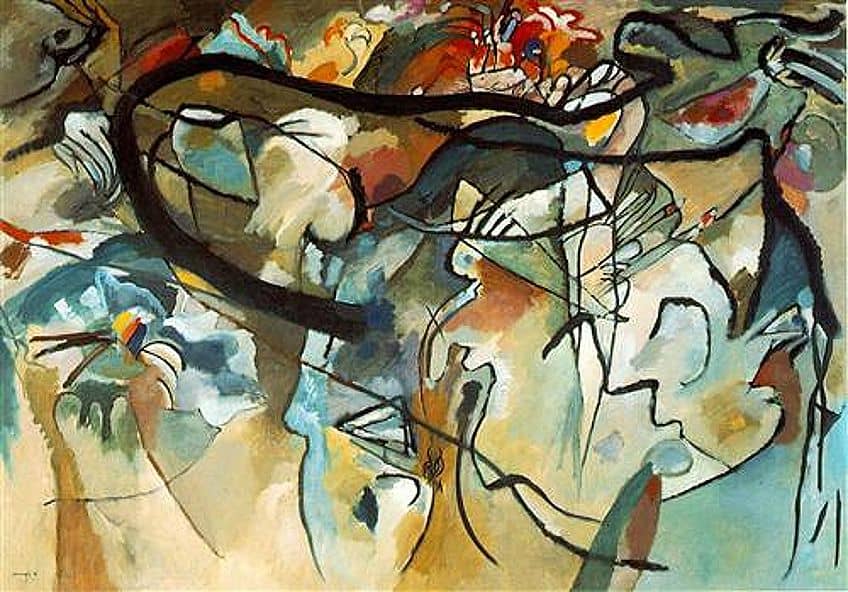
Non-Objective Painting no. 80 (Black on Black) (1918) by Aleksandr Rodchenko
| Artist Name | Aleksandr Rodchenko (1891 – 1956) |
| Date | 1918 |
| Medium | Oil and bitumen on canvas |
| Dimensions (cm) | 81.9 x 79.4 |
| Where It Is Housed | Museum of Modern Art, New York City, United States |
Another major painter and sculptor of the non-objective art style was Russian artist Aleksandr Rodchenko. Rodchenko was a pioneering artist of the Constructivist movement who specialized in photomontage, which influenced his painting quality. By 1920, Rodchenko delved into the utopian ideal of abstraction by producing monochrome paintings that expressed his view of painting as simplified versions of logical conclusions. His paintings functioned as affirmations of his logic, which expressed the philosophy of simplicity in non-objective art.
Non-Objective Painting no. 80 formed part of Rodchenko’s series Black on Black, which was a response to Malevich’s white painting series and retort to the Black Square.
In presenting a contrasting series, Rodchenko challenged the fundamental ideas of Suprematism by incorporating a variety of textures and highlighting the materiality of the painting’s surface. The gestural curvatures also allude to dynamic motion, which further builds on the possibilities for simplicity to be found in motion and texture while retaining the simplicity of form. The conversation of painting quality and the meeting of minds between Rodchenko and Malevich highlight the nature of non-objective art, which freed artists from the representation and control of the object and became a form of liberation from institutional traditions.
Suprematist Composition: White on White (1918) by Kazimir Malevich
| Artist Name | Kazimir Severinovich Malevich (1879 – 1935) |
| Date | 1918 |
| Medium | Oil on canvas |
| Dimensions (cm) | 79.4 x 79.4 |
| Where It Is Housed | Museum of Modern Art, New York City, United States |
Kazimir Malevich was one of the leading non-objective artists of the 20th century who prioritized the use of lines and geometric shapes in his art. This became known as geometric abstraction and was one of the most impactful art styles in Modern art. Malevich also produced an important text on non-objective art, which was published in 1926 called The Non-Objective World: The Manifesto of Suprematism and outlined a non-objective art definition as artworks that produce a novel world composed of elements that mean nothing. These elements include shapes, colors, and lines, which help put the definition of non-objective art into perspective.
Suprematist Composition: White on White is a non-objective painting by Malevich that illustrates a white square floating in the middle of the white space of the canvas.
The painting was considered a radical artwork of the early 20th century since it made no clear connection to external reality. What makes the non-objective painting so interesting is its inclusion of Malevich’s handprint and traces of his gestures in white paint. The image of the square is also not entirely symmetrical and emphasizes a space unconfined to any limits. A primary fascination in Malevich’s work was also the airplane and technology that manifested in the artist’s interest in aerial photography and generating a sense of transcendence. The color white was also significant to Malevich’s philosophy and practice since he believed that the color was a symbol of a utopian world and a color that represented a truer form. This resulted in the invention of his own theory as Suprematism, which privileged the supremacy of “pure feelings or the perception in pictorial art”. He also advocated for the approach that an image’s form had no relation to nature.
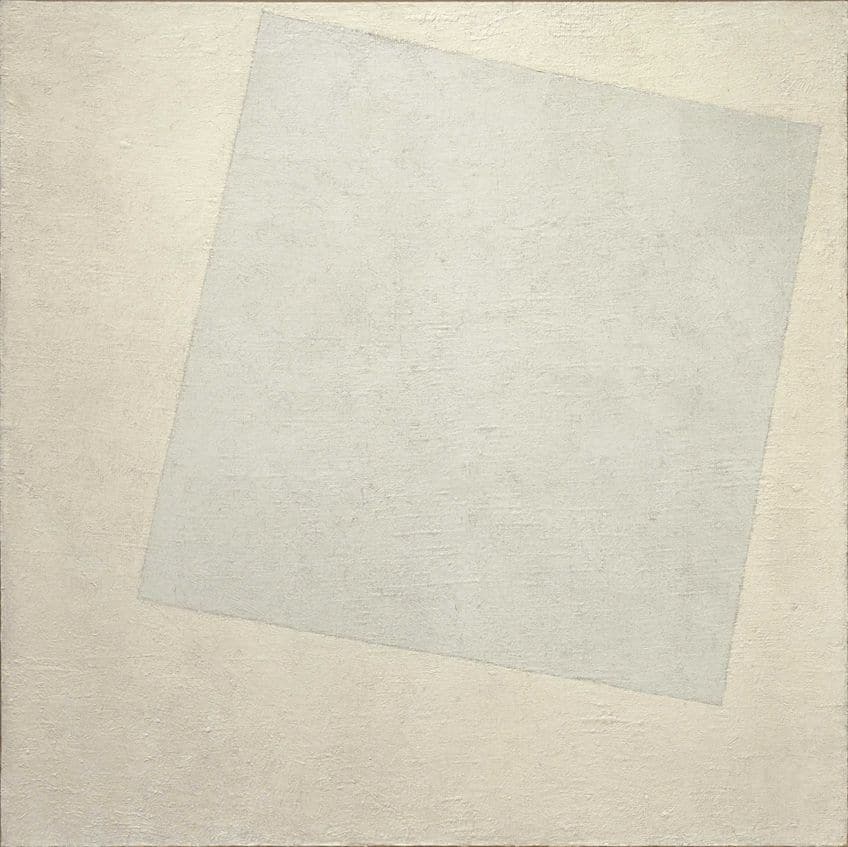
Construction in Space: Diagonal (1921 – 1925) by Naum Gabo
| Artist Name | Naum Gabo (1890 – 1977) |
| Date | 1921 – 1925 |
| Medium | Metal, glass, and plastic |
| Dimensions (cm) | 61 x 16.3 x 16 |
| Where It Is Housed | Tate Gallery, London, United Kingdom |
Naum Gabo was a highly influential sculptor and post-Russian Revolution Avant-Garde artist who operated across many of the major non-objective art movements, including Futurism, Bauhaus, Constructivism, and De Stijl. One of Gabo’s key texts was the Realistic Manifesto written in partnership with Antoine Pevsner, his brother.
Gabo’s approach to abstract art was also built on utopian beliefs and the desire to relay the human experience through concepts such as spirituality and scientific advancement, which would place his work in sync with modernity.
Construction in Space: Diagonal is one of Gabo’s most famous abstract assemblages that features interlocking components with two rectangular open frames. Gabo also included clear glass and celluloid shapes to elevate the visual layers of the sculpture and invite the viewer to observe through the shape and dematerialization of the sculpture. Gabo also drew connections between scientific tools and Modernist architecture, which developed at a rapid rate in the 20th century.
Two Grays II (1928) by Frantisek Kupka
| Artist Name | Frantisek Kupka (also known as Frank Kupka) (1871 – 1957) |
| Date | 1928 |
| Medium | Oil on canvas |
| Dimensions (cm) | 38 x 63 |
| Where It Is Housed | Unavailable |
Frank Kupka was a famous Czech artist who was best known for the abstract art movement Orphism. Kupka’s exploration of abstract and non-objective art was inspired by his search for a parallel to music, which is highlighted in many of his paintings that appear lyrical in color and incorporate many abstract geometric forms. Two Grays II is a painting by Kupka that represents the preliminary phase in his transition to non-objective art. Kupka also had a strong interest in color theory and expressed the desire to free color from traditional descriptive affiliations. Paintings such as The Yellow Scale (1907) also highlight Kupka’s ability to develop his unique approach to color theory, resulting in a series known as the Discs of Newton. By 1931, Kupka founded an important collective called the Abstraction-Creation group, which broadened his circle and introduced him to other emerging abstract movements.
Many of Kupka’s best works can be found in many prestigious art collections, including the Pompidou Centre and the Musee National d’Art Moderne.
Blue Construction (1938) by Roland David Smith
| Artist Name | Roland David Smith (1906 – 1965) |
| Date | 1938 |
| Medium | Steel and baked enamel |
| Dimensions (cm) | 92.1 x 72.4 x 76.2 |
| Where It Is Housed | Hauser and Wirth, New York City, United States |
Blue Construction is a fascinating abstract steel sculpture with a hand-brushed enamel finish, created by American non-objective artist Roland David Smith. Smith was a famous abstract expressionist of the 20th century who skillfully combined sculpture with abstraction to create balanced works that demonstrate the relationship between positive and negative space. Smith is most famous for his approach to sculpture, described as “drawings in space”, which highlighted his talent for making the geometry of steel sculpture feel and look more fluid.
Blue Construction is one of his best early explorations of such ideas in sculpture that defined his process and philosophy when approaching three-dimensional artworks.
Key influential moments in Smith’s work include the 1938 Nazi Germany domination, the spread of panic by the media, and the Bauhaus: 1919 – 1928 exhibition at the Museum of Modern Art. All of these major art and historical events surrounding Smith’s work also evolved around the concept of travel and flight, which informed Smith’s concept. Blue Construction was also a reflection of not only the significant events in its production environment but also Smith’s recognition and appreciation for the scale and the monument concerning the land.
Synchromy in Dark Blue (1941) by Auguste Herbin
| Artist Name | Auguste Herbin (1882 – 1960) |
| Date | 1941 |
| Medium | Oil on canvas |
| Dimensions (cm) | 70.8 x 91.5 |
| Where It Is Housed | Museum of Modern Art, New York City, United States |
Synchromy in Dark Blue is an abstract non-objective painting by French Modern artist Auguste Herbin that illustrates the artist’s colorful approach to non-objective art through sharp geometric compositions. Alongside figures such as Frank Kupka, Herbin promoted non-figurative abstract practices and helped co-found crucial artist associations such as the Salon des Réalités Nouvelles and the Abstraction-Création group. Herbin’s experiments with art styles found in Fauvism and Cubism were key to the development of his art style as seen in Synchromy in Dark Blue.
The painting reflects a sense of dynamism with Modern sharp geometric shapes and a sense of control over the flow and movement of the shapes.
Fluorescent Complement (1960) by Richard Anuszkiewicz
| Artist Name | Richard Anuszkiewicz (1930 – 2020) |
| Date | 1960 |
| Medium | Oil on canvas |
| Dimensions (cm) | 91.5 x 82 |
| Where It Is Housed | Museum of Modern Art, New York City, United States |
Richard Anuszkiewicz was a famous American Op art painter whose experimental approach to abstract Op art resulted in some of the most fascinating Modern paintings. Anuszkiewicz’s paintings were inspired by the art of Josef Albers, especially the juxtaposition and experimentation with color. The playfulness of Anuszkiewicz’s paintings is drawn out through his art style, which highlighted the different changes that occur with the relationships between optical illusions, geometric configurations, and high-intensity colors. Anuszkiewicz summarized his approach to non-objective and Op art as an investigation of the effect of high-intensity complementary colors and their relationship with optical illusions such that his practice allowed him to explore the effects of light on color and the way it is perceived. Fluorescent Complement is a speckled painting that illustrates the simple shift in the luminosity of the spots as the background color of the painting changes.
Anuszkiewicz used a simple approach to demonstrate his experimental view of color and interest in the slight changes in value that lead to significant shifts in color.
Study for Homage to the Square (1964) by Josef Albers
| Artist Name | Josef Albers (1888 – 1976) |
| Date | 1964 |
| Medium | Oil on fiberboard |
| Dimensions (cm) | Support: 76.2 x 76.2; and frame: 78 x 78 x 3 |
| Where It Is Housed | Tate Gallery, London, United Kingdom |
Josef Albers was one of the most famous abstract artists of the 20th century whose artworks encapsulated the non-objective concept. His series Homage to the Square was one of the most influential developments in non-objective art that utilized the geometric shape of the square to evoke chromatic harmony in abstract art. Albers’ painting style was associated with concrete art, another term interchanged with non-objective art, and took off by 1950. Homage to the Square demonstrated the artist’s use of color combinations through the mediums of lithography, painting, and other printmaking techniques that were executed on Masonite. Albers also provided insight into his ideas on color pigments as mentioned in his publication in 1963, Interaction of Colour.
Albers also founded his approach to painting on principles of the Bauhaus movement, with his series based on the principles of design as well as an analysis of form, space, and color.
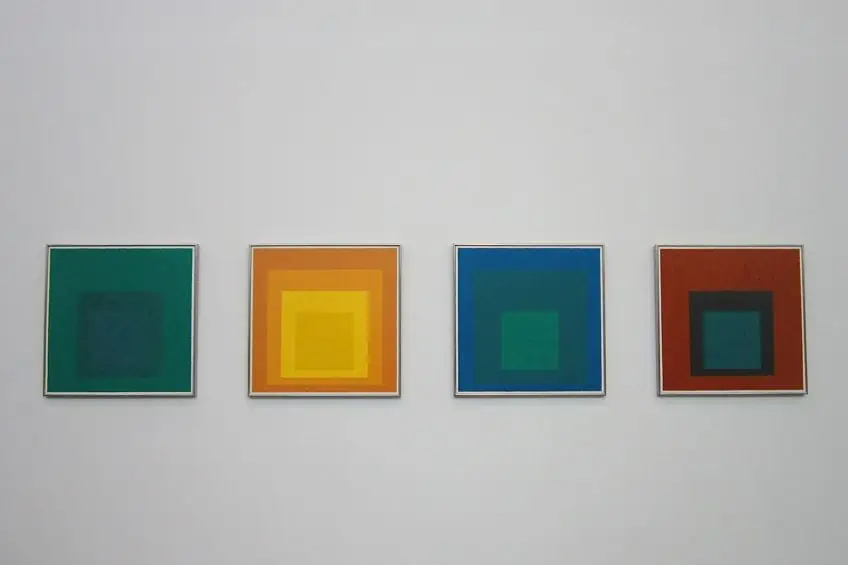
Table Piece CCLXVI (1975) by Sir Anthony Caro
| Artist Name | Sir Anthony Alfred Caro (1924 – 2013) |
| Date | 1975 |
| Medium | Steel |
| Dimensions (cm) | 79.5 x 205.5 x 125 |
| Where It Is Housed | Tate Gallery, London, United Kingdom |
Sir Anthony Caro was one of the most prolific English sculptors of the 20th century whose metal assemblages have revolutionized the genre of abstract sculpture. Caro’s sculptural style was associated with the Modernists and became part of the genre of sculptors whose works were lauded as the best of the best in England. Caro’s previous experience working with Henry Moore in the mid-20th century as well as an introduction to the sculptural works of David Smith helped realign his vision with sculpture and led to his global recognition by the 1950s. In his success leading up to the 21st century, Caro had been knighted and also awarded the Order of Merit in 2000 alongside numerous other awards for his contributions to sculpture.
Table Piece CCLXVI is a life-sized sculpture that reflects his sculptural style and interest in human-sized sculpture since the 1960s.
Despite the works being conceived as “modest”, Caro’s table sculptures functioned as artworks in their own right rather than maquette-sized works when compared to his larger sculptures. The sculpture was created using strips of metal bent into ribbon-like folds and curves to highlight the tension and the nature of the material. The structure also mirrors the image of a human with outstretched arms, which helps the viewer draw some form of relation to the seemingly remote and abstract sculpture. Another highlight of the sculpture is the part that hangs over the edge and thus established its interaction with the real world through its structural function. This also points out the importance of the existence of the work; that it can only exist in the context of being exhibited on top of a table or wall structure.
Riallaro (1995) by Frank Stella
| Artist Name | Frank Philip Stella (1936 – Present) |
| Date | 1995 |
| Medium | Screen-print, lithograph, etching, relief, aquatint, and collagraph on white TGL paper (handmade) |
| Dimensions (cm) | 117.5 x 81.9 |
| Where It Is Housed | Anders Wahlstedt Fine Art, New York City, United States |
Frank Stella is one of the most famous non-objective artists to date who is best known for his contributions to Minimalism and a style described by Clement Greenburg as a post-painterly abstraction. Stella’s approach to non-objective painting first began after the emergence of abstract works by Jasper Johns and Barnett Newman in the mid-20th century. Stella offered a new interpretation of the idea of the image or picture and stated that a picture was simply a flat surface with paint on it and nothing more.
This direct approach to image-making was further developed throughout the 1960s with Stella’s adoption of copper and aluminum paint with solid lines of color separated by thin stripes.
Riallario is a unique combination of different printmaking techniques to portray an assemblage of patterns composed of nets, warped lines, dots, and irregular shapes. Irregular shapes also debuted in Stella’s work in his selection of irregular canvases that differed from the traditional square shape. The unique combination of intricate irregular patterns and neon colors of the print makes it one of the most intriguing non-objective artworks of the late 20th century.
Brushstrokes (1995) by Sol LeWitt
| Artist Name | Solomon LeWitt (1928 – 2007) |
| Date | 1995 |
| Medium | Gouache on paper |
| Dimensions (cm) | 28 x 19 s |
| Where It Is Housed | CAMUSAC Cassino Museum of Contemporary Art, Cassino, Italy |
Sol LeWitt was one of the most famous non-objective artists of the 20th century whose works across the Conceptual art and Minimalist movements have secured his artistic legacy. LeWitt debuted in the 1960s with his “structures” or sculptures, wall drawings, and artist books. By the 1990s, LeWitt started exploring geometry in abstract art, which marked the beginning of his wavy geometric paintings and free-flowing brushwork. His work, Wavy Brushstroke, was created in the same year as Brushstrokes sold for $750,000 in 2014. Toward the end of the 90s, LeWitt expanded his experimental process into different mediums such as printmaking and photolithography.
Works such as Brushstrokes reflect LeWitt’s introduction of gouache, a water-based medium, that allowed for the fluidity that one encounters in his work. Many of LeWitt’s gouache works were informed by particular motifs and were created by hand, which was uncommon for LeWitt at the time. The loose and rough brushwork coupled with a fresh balance of cool and warm-toned strips of color elevate the abstract nature of the painting to create a unique signature. Today, many of his prints can be found in the permanent collections of many renowned institutions, including the Whitney Museum of American Art and the Museum of Modern Art.
The role of non-objective art in establishing innovative ways of interpreting and creating abstract artworks has been incredibly impactful to Modern art. We hope that this article has helped deepen your understanding of non-objective art, and the different ways it has been realized in the recent past.
Frequently Asked Questions
What Is Non-Objective Art?
Non-objective art refers to art that does not intend to represent a specific object, subject, or form. Non-objective art is also referred to as non-representational art, and is a form of abstract art that emerged in the 20th century.
What Is the Difference Between Non-Objective Art and Abstract Art?
The primary difference between non-objective art and abstract art is the artist’s approach to the subject of the painting. If the artwork is based on reality, then it is regarded as abstract, however, if it draws from no real-world object or subject from reality, then it can be considered non-objective.
Who Are the Most Famous Non-Objective Artists?
The most famous non-objective artists are considered to be Naum Gabo, Wassily Kandinsky, Piet Mondrian, Kazimir Malevich, and Mark Rothko.
Jordan Anthony is a Cape Town-based film photographer, curator, and arts writer. She holds a Bachelor of Art in Fine Arts from the University of the Witwatersrand, Johannesburg, where she explored themes like healing, identity, dreams, and intuitive creation in her Contemporary art practice. Jordan has collaborated with various local art institutions, including the KZNSA Gallery in Durban, the Turbine Art Fair, and the Wits Art Museum. Her photography focuses on abstract color manipulations, portraiture, candid shots, and urban landscapes. She’s intrigued by philosophy, memory, and esotericism, drawing inspiration from Surrealism, Fluxus, and ancient civilizations, as well as childhood influences and found objects. Jordan is working for artfilemagazine since 2022 and writes blog posts about art history and photography.
Learn more about Jordan Anthony and about us.
Cite this Article
Jordan, Anthony, “Non-Objective Art – Creation in the Absence of Representation.” artfilemagazine – Your Online Art Source. October 10, 2023. URL: https://artfilemagazine.com/non-objective-art/
Anthony, J. (2023, 10 October). Non-Objective Art – Creation in the Absence of Representation. artfilemagazine – Your Online Art Source. https://artfilemagazine.com/non-objective-art/
Anthony, Jordan. “Non-Objective Art – Creation in the Absence of Representation.” artfilemagazine – Your Online Art Source, October 10, 2023. https://artfilemagazine.com/non-objective-art/.


